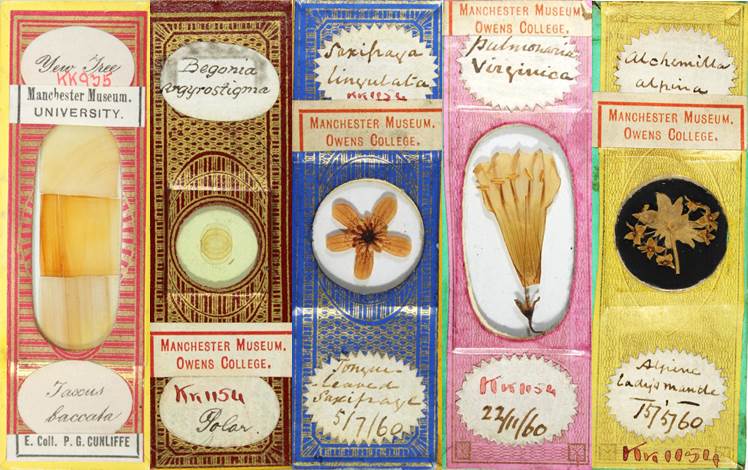By Rachel Webster
At this time of year, there is always that one person who is impossible to buy a gift for. What do you get a botanist who has everything? Well, how about some microscope slides?
As we’ve been working our way through Manchester Museum’s 15,000 microscope slide collection, I can’t help but imagine some of these as presents. For starters, there’s all that beautiful paper; no gift is complete without the careful wrapping. Early microscope slides were wrapped in paper to keep the coverslip in place on top of the specimen. Other methods for attaching the coverslip were developed, but some slide preparators continued to use the papers for decoration.
Just imagine the fun your botanical friend could have looking at the finer details of the fruit and veg and sharing their findings over the Christmas dinner. While the word ‘fruit’ in English is used for many sweet-tasting plant parts, its use is much more specific in botany. There are a considerable number of ways by which any aspiring botanist can learn to describe their fruits and distinguish one kind from another. They might offer a slice of soft, juicy, pickled pepo (cucumber) with the cheese, warn fellow diners to take care with the hard stone in their delicious drupe (date), join in the struggle to break into a true nut (walnut) and, my personal favourite, uncover the zesty heperidium (tangerine)at the bottom of their Christmas stocking. Not forgetting, of course, there is always the chance to put people off their dessert by explaining the intricate way that the highly specialised fig flower structure is visited by wasps and develops into the culinary fruit (technically known as a syconium; I wonder if that would get a good score in Scrabble?).
The slides could be an opportunity to avoid another round of charades and escape to some quiet contemplation! Perhaps of the Christmas tree in extraordinary detail. Just imagine the pleasure getting lost for hours in the patterns created by slicing the timber in different directions, with or across the grain. Or maybe a close investigation of a local nativity scene – is that really hay in the manger? Or is it a much scratchier bed of straw?
The fortunate recipient of your microscopical gifts can follow in the footsteps of Mr George Wilks, who was clearly snipping bits off the decorations in 1903. Perhaps he needed to test out a new microscope from Santa.
Read the full story at Herbology Manchester.
Links:
- Paper: https://blogs.reading.ac.uk/crg/2014-advent-botany-day-13-paper/
- Poaceae: https://blogs.reading.ac.uk/crg/advent-botany-2015-day-16-straw-or-hay-which-will-make-dr-ms-day/
- Christmas tree: https://blogs.reading.ac.uk/crg/2014-advent-botany-day-15-the-christmas-tree/
- Dates: https://blogs.reading.ac.uk/crg/2014-advent-botany-day-21-dates-phoenix-dactylifera/
- Ivy: https://blogs.reading.ac.uk/crg/2014-botanical-advent-calendar/
- Walnut https://blogs.reading.ac.uk/crg/advent-botany-2015-day-5/
- Tangerine: https://blogs.reading.ac.uk/crg/advent-botany-2015-day-18-the-tangerine/
- Cucumber/pickles: https://blogs.reading.ac.uk/crg/advent-botany-2016-gherkin/
- Fig: https://blogs.reading.ac.uk/crg/virgin-birth/
- Fruit: https://awkwardbotany.com/2014/10/04/22-botanical-terms-for-fruits/ and https://botanistinthekitchen.blog/2013/02/04/pomegranates-and-the-art-of-herbivore-attraction/
- Microscope slides http://www.victorianmicroscopeslides.com/history.htm




